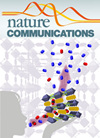投稿信息
稿件收录要求
Nature Communications is an open access journal that publishes high-quality research from all areas of the natural sciences and has an Impact Factor of 11.470 according to the 2014 Journal Citation Reports®Science Edition (Thomson Reuters, 2015). This places Nature Communications third among all multidisciplinary science primary research journals, with Nature being first. Papers published by the journal represent important advances of significance to specialists within each field.
Manuscript submissions
Please see our brief guide to manuscript submission in PDF format for an overview of key information on submitting primary research for publication in Nature Communications.
The guide to publication policies of the Nature journals (including the guide for referees), is also available inPDF format.
投稿需知:http://www.nature.com/ncomms/authors/submit.html
Aims and scope of the journal
Nature Communications is an open access, multidisciplinary journal dedicated to publishing high-quality research in all areas of the biological, physical, chemical and Earth sciences. Papers published by the journal represent important advances of significance to specialists within each field.
The scope of the journal reflects Nature Publishing Group''''''''''''''''s core strength in the natural sciences, and includes areas in which Nature research journals serve to publish the most outstanding community-focused research papers. In addition, Nature Communications encourages submissions in fields that aren''''''''''''''''t represented by a dedicated Nature research journal; for example developmental biology, plant sciences, microbiology, ecology and evolution, palaeontology and astronomy. The editors particularly welcome submissions from cross-disciplinary fields, including biophysics, bioengineering, chemical physics and environmental science, although no area is excluded from consideration. In all cases, papers published inNature Communications will be of high quality, without necessarily having the scientific reach of papers published in Nature and the Nature research journals.
Nature Communications is committed to providing an efficient service for both authors and readers. A streamlined peer-review system, together with the support of an Editorial Advisory Panel, allows a team of independent editors to make rapid and fair publication decisions. Prompt dissemination of accepted papers to Nature Publishing Group''''''''''''''''s wide readership and beyond is achieved through a programme of continuous online publication. Published manuscripts are enhanced by innovative web technologies, including interactive browsing and efficient data- and text-mining.
Nature Communications is editorially independent, and its editors will make their own decisions independently of the other Nature journals. It is for authors alone to decide where to submit their manuscripts. Nature will continue to publish the most significant advances in science and the Nature research journals will publish landmark papers of interest to their specific communities. Nature Communications will publish high-quality papers from all areas of science that represent important advances within specific scientific disciplines, but that might not necessarily have the scientific reach of papers published in Nature and the Nature research journals. For papers that could satisfy the scope of more than one Nature journal, the choice of which journal to submit to first lies with the authors.
If a paper is rejected from one Nature journal, the authors can use an automated manuscript transfer service to submit the paper to Nature Communications via a link sent to them by the editor handling the manuscript. Authors should note that referees'''''''''''''''''''''''''''''''' comments (including any confidential comments to the editor) and identities are transferred to the editor of the second journal along with the manuscript. The journal editors will take the previous reviews into account when making their decision, although in some cases the editors may choose to take advice from additional referees. Alternatively, authors may choose to request a fresh review, in which case they should not use the automated transfer link, and the editors will evaluate the paper without reference to the previous review process.
Nature Communications differs from other Nature journals in that editors occasionally seek advice from members of an Editorial Advisory Panel in deciding whether to review manuscripts. Further information about the Editorial Advisory Panel can be found in the Guide to Authors.




